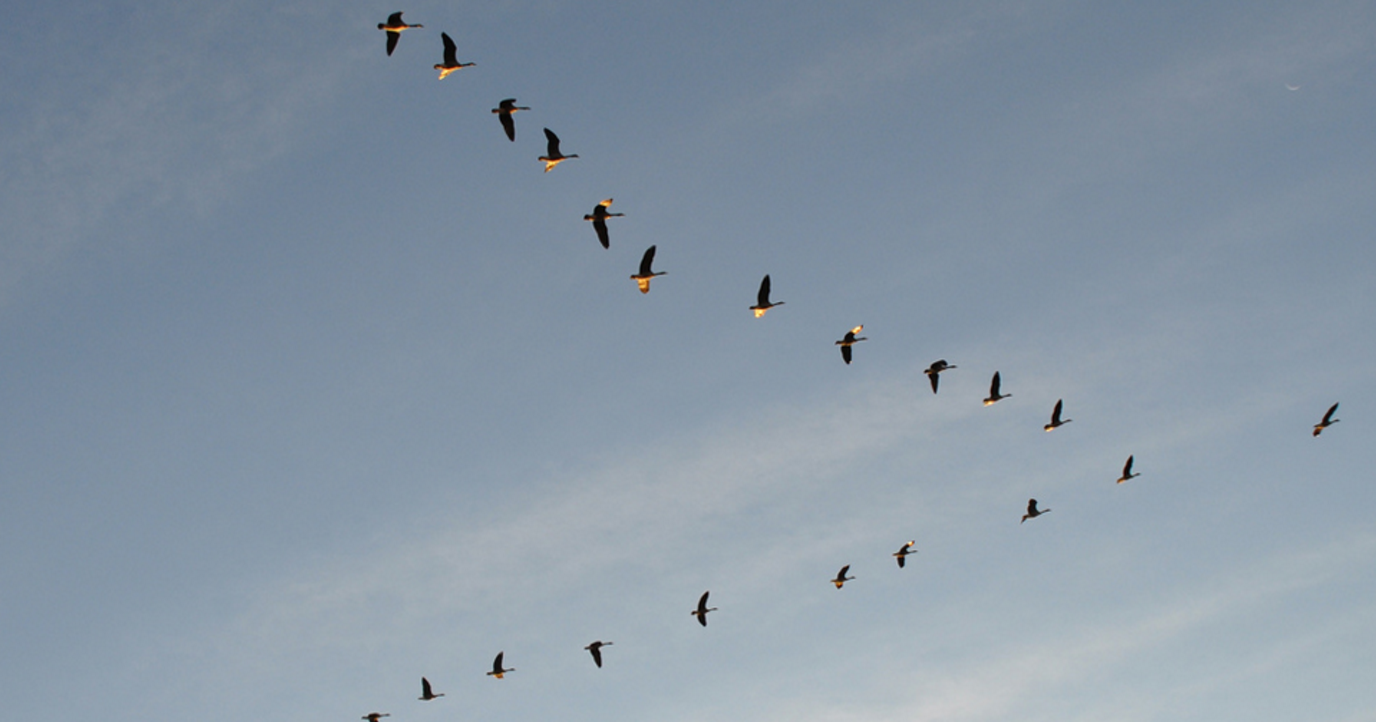Audubon's Blog: Birds of a Feather
Contributed by Bill Hamilton
The end of summer and start of fall is a great time to observe flocks of birds. Large birds, like geese for example, are starting to fly in specific geometric formations (the “V’s”) in order for individuals in the flock to take advantage of both reduced wind resistance and also the up-wash of air that a front-flying bird generates both behind it and to its sides. Birds flying in a “V” formation beat their wings less often than a bird flying alone and also have lower heart rates. Therefore, they are able to glide more and use substantially less energy to power their flying.
Smaller birds, like blackbirds, starlings, and grackles, do not generate large enough air vortices to assist birds flying near them. So, there is no energetic advantage to flying in a “V.” These birds tend to fly in large, shape-changing flocks that can number from many thousands to several million individuals Watching these swirling and flowing flocks can be a surreal experience! The coordinated twisting and turning movements that they display suggests an immense, living being rather than simply a mob-like mass.
- The emergent patterns of these small bird flock movements are generated by the expression of three very simple rules of dynamics: Separation: each individual in the flock tries to maintain an optimal distance from its neighbors,
- Alignment: individuals steer in the average direction their neighbor is going, and
- Cohesion: each individual maintains a standard density of individuals in space.
These three rules are seen not only in flocks of birds but also in schools of fish, herds of mammals, and even in crowds of people, Complex group movements result as each individual in the group tries to keep their spacing, alignment, and crowd density constant.
Flocks (or schools or herds) may seem to be a huge disadvantage for a prey species seeking not to be noticed by a predator. Any predator could see or hear or smell a flock or a herd of thousands to millions of individuals! There are, though, many consequences of being in a large crowd that might lessen the impact of predation on an individual, and these benefits have probably been sorted out via natural selection and evolution to generate optimal sizes and timings of these flocks, herds, or schools.
The most obvious benefit is “safety in numbers.” There are many eyes (and noses and ears) “watching” for predators. A large group should always have someone watching each point in space around them. Also, there are so many other individuals around for a potential predator to take! This simple risk reduction by large available numbers of prey of equal or even greater quality may be sufficient to offset the increased risk from excessive visibility. This has been referred to as the “dilution effect” in which risk decreases when it is shared over an increasing
number of individuals.
Flocks (or schools or herds) may also confuse predators via their mass movements or obstruct their access to specific individuals by their spacing and density. Some animals take turns rotating from the edges of their flock/herd/school into the more protected center. Many species also keep the more vulnerable individuals of their group (especially young individuals) inside these protected centers and the larger, more robust adults on the more vulnerable edges.
Birds form winter flocks for other reasons, too. Finding food is major task in the winter and being in a large group of fellow food seekers makes the probability of finding food much higher. Even though whatever food is found is then shared by many “beaks,” the net gain of food opportunities more than offsets the loss due to smaller individual portions.
